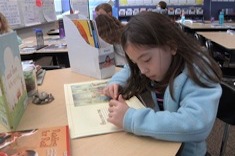The beginning of the year is an exciting time: new possibilities, fresh faces, shy smiles. There’s a lot to teach, and I tend to over-plan, moving lessons from one day to the next. It’s hard to judge how long that icebreaker will last, or the amount of time it will take to practice lining up. Not to mention extras like assemblies and fire drills.
But there’s one procedure that I always introduce on the first day of school, no matter what: independent reading. Despite its numerous benefits, like promoting a love of reading, empowering student choice, and providing meaningful independent work for students, this task can appear colossal.
Maybe you have asked yourself questions like these: How am I supposed to get my seven-year-olds to concentrate on their books? How do I make sure they are actually reading (not just pretending to turn the pages)? How do I maintain sanity during the process??
In the classic short picture book The Carrot Seed, by Ruth Krauss, a boy plants a carrot seed. Afterward, each family member comes to him and says, “It won’t come up.” Undeterred, he continues to sprinkle water on the dirt and pull up weeds, checking on his seedling regularly.
Are you getting the metaphor? Your students are like those seeds in the ground—tiny, fragile, full of hope. In September, when you launch independent reading (and countless other routines), it may seem like they are stuck in a dormant state. Don’t give up! They are burrowing in the soil, forming roots, establishing their places. If you stay focused, positive, and patient, they will bloom in no time!
Here are a few tips to successfully kick off independent reading with your readers:
Have your classroom library ready for the first day of school.
The importance of this cannot be overstated. Your excitement around reading is contagious—let it rub off on your students! When students see popular and interesting book titles displayed attractively, they will jump at the chance to start reading. On the other hand, if they glimpse dusty, cluttered shelves with no clear organizational system, their interest levels will quickly wane.
Books can be sorted in multiple ways: by genre (nonfiction, fiction, chapter books, graphic novels, poetry), author, series, and theme. If you have an open-face shelf, place books in it related to the beginning of the year or other favorites. Less is more; you don’t need to put every book out on the shelf on day one. Instead, rotate additional titles in as the year progresses.
Make a list of independent reading procedures to teach one at a time.
For example, on the first day of school, I show my class how the library is organized and let the students select a book. On day two, I teach them how to choose a “good-fit” text using the framework from The Daily Five, by Gail Boushey and Joan Moser. On the third day, I model reading expectations (looks like, sounds like). Check out The Daily CAFE for more Read to Self resources. And don’t worry if certain lessons require reteaching. That’s to be expected!
Observe your students as they are reading.
Take note of who has trouble getting settled, who switches back and forth between multiple books, who pretends to read every time they catch you watching. Make a plan to support these kiddos: Are they reading books that are too hard or too easy? Are they having trouble finding engaging selections? By problem solving, you are moving them into the sun and watering their wilted leaves.
Track reading stamina with a chart.
During those first few days, I time the students and stop them as soon as one child gets off task. This may be only one to two minutes (or less!) into the lesson. That’s okay! Ending the session ensures that students don’t develop negative habits early in the year. They will get better, I promise.
Acknowledge their progress as they read for longer stretches of time. Stick to your goals and keep teaching (and reteaching procedures), and in a few weeks, a silent hush will fall over the room as the students read. The stamina chart will expand, and eventually, you won’t need it anymore.
Have brief discussions at the end of each session to reflect.
How did it go today? What did we do well? What can we do better tomorrow? Remember to celebrate all successes, even the tiny ones. “We improved by 30 seconds today! Everyone opened their books right away, without reminders.” As a former colleague of mine likes to say, “Water what you wish to grow.”
Collaborate with your teammates.
If possible, strategize together and connect afterward to check in. Maybe that’s just a thumbs-up (or down!) as you pass each other in the crowded hallway during a transition to specials. Knowing that you’re working toward the same result provides support during those inevitable moments of frustration.
Ready to get started? These ideas are not exhaustive, nor is there a “one size fits all” approach. Instead, create a road map that works for you and your students. Plant your seeds, and give them sunlight and water ever day. After a few weeks, they will come up.
Just like you knew they would.



